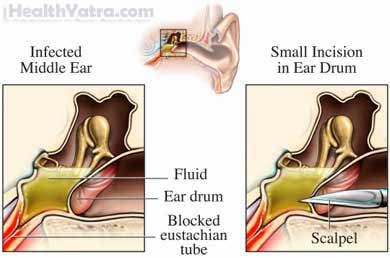Myringotomy Cost in India
A myringotomy is a procedure to put a hole in the ear drum. This is done so that fluid trapped in the middle ear can drain out. The fluid may be blood, pus, and/or water. In many cases, a small tube is inserted into the hole in the ear drum. The tube helps to maintain drainage. This surgery is most often done on children, but is sometimes done on adults.
Reasons for Procedure
A myringotomy may be done:
- To help treat an ear infection that is not responding to medical treatment
- To restore hearing loss caused by fluid build-up and to prevent delayed speech development caused by hearing loss in children
- To take sample fluid from the middle ear to examine in the lab for the presence of bacteria or other infections
- To place tympanostomy tubes—These tubes help to equalize pressure. It may also help prevent recurrent ear infections and the accumulation of fluid behind the ear drum.
After the procedure, pain and/or pressure in the ear due to fluid build-up should be alleviated. Hearing loss due to fluid build-up should improve as well.
Possible Complications
Complications are rare, but no procedure is completely free of risk. If you are planning to have a myringotomy, your doctor will review a list of possible complications, which may include:
- Bleeding
- Infection
- Failure of the myringotomy incision in the ear drum to heal as expected
- Hearing loss
- Injury to ear structures other than the ear drum
- Need for repeat surgery
What to Expect
Prior to Procedure
Your doctor will likely do the following:
- Blood tests
- Hearing test
- Tympanogram—a test that measures how well the ear drum responds to changes in pressure
- Examine the external ear and the ear drum with a special instrument called an otoscope
Leading up to your procedure:
- Arrange for a ride to and from the procedure.
- Do not eat or drink anything for at least eight hours before the procedure.
Talk to your doctor about your medicines. You may be asked to stop taking some medicines up to one week before the procedure, like:
- Aspirin or other anti-inflammatory drugs
- Blood thinners, such as clopidogrel (Plavix) or warfarin (Coumadin)
Anesthesia
General anesthesia is most often used. You will be asleep. In some cases, a local anesthetic will be used to numb the ear.
Description of Procedure
A small microscope is placed in position to give the doctor a better view. A tiny incision will be made in the eardrum. Fluid from the middle ear will then be drained. In most cases, a small tube will be inserted and left in place. This will allow the drainage to continue.
No stitches will be used to close the incision. The incision will heal itself. The procedure is often done on both ears. Some doctors may use a laser beam to make the opening in the ear drum.

How Long Will It Take?
The surgery will last about 15–20 minutes.
Will It Hurt?
Anesthesia prevents pain during surgery. You may have minor pain after surgery. Your doctor can give you pain medicine or recommend a nonprescription pain reliever to manage this discomfort. Also, lidocaine ear drops may be given to decrease pain.
If ear tubes are inserted, you may feel popping, pulsation, clicking, or minor pain when burping, chewing, or yawning until the ear heals around the tubes.
Postoperative Care
After the procedure, be sure to follow your doctor’s instructions , which may include:
- If cotton was placed in the ear canal to absorb postsurgical drainage, change it regularly. (Drainage should end or reduce to a minimal amount within 2-3 days.)
- If you are given ear drops, use as directed. You will usually put three drops in each ear, three times a day for three days after surgery.
- If water gets in the ear after surgery, monitor for drainage. If drainage begins, use ear drops if directed by your physician, and if drainage continues for three days (or as directed), call your doctor.
- To speed healing, resume normal activities as soon as possible.
- Take any medicines as prescribed by your doctor.
- Use ear plugs as prescribed by your doctor while swimming or bathing, and avoid underwater swimming and diving unless instructed otherwise.
- Do not drive for at least 3-4 days after surgery.
- See your doctor for any needed tests.
- Do not clean your ear after surgery or place anything other than ear drops, cotton, or ear plugs into the ear, unless instructed otherwise by your doctor.
- Ask your doctor about when it is safe to shower, bathe, or soak in water.
Complete healing without complications should occur within four weeks. If ear tubes were inserted, they should fall out within 6-12 months. In some cases, surgery to remove the ear tubes may be necessary. Most ear drums heal normally after tubes come out, but visible scarring is not unusual.
Call Your Doctor
After arriving home, contact your doctor if any of the following occurs:
- Signs of infection, including fever and chills
- Redness, swelling, increasing pain, excessive bleeding, or discharge from the ear
- Pain that you cannot control with the medicines you have been given
- Drainage from ear continues for more than four days after surgery
- Decreased hearing
- Cough, shortness of breath, chest pain, or severe nausea or vomiting
- Any other new concerns
In case of an emergency, call for medical help right away.
